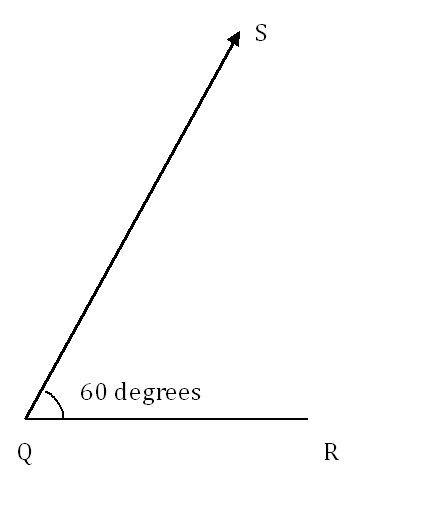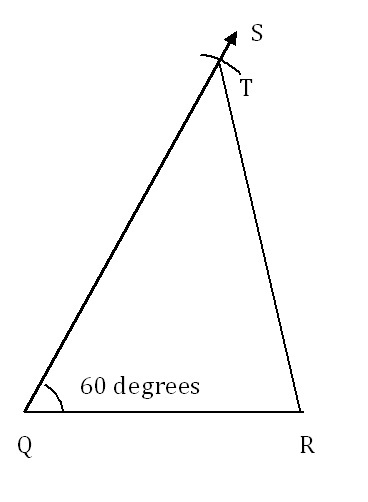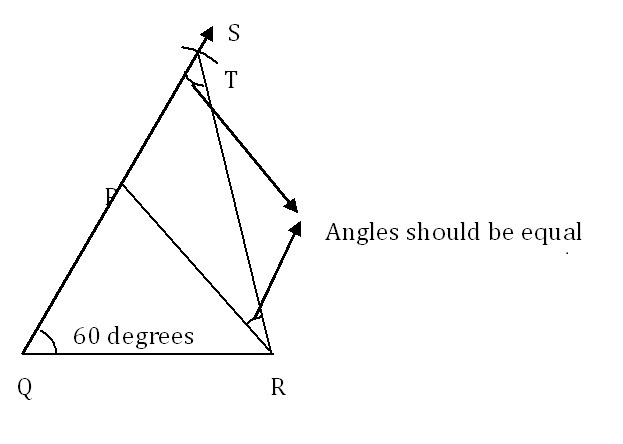
 Data Structure
Data Structure Networking
Networking RDBMS
RDBMS Operating System
Operating System Java
Java MS Excel
MS Excel iOS
iOS HTML
HTML CSS
CSS Android
Android Python
Python C Programming
C Programming C++
C++ C#
C# MongoDB
MongoDB MySQL
MySQL Javascript
Javascript PHP
PHP
- Selected Reading
- UPSC IAS Exams Notes
- Developer's Best Practices
- Questions and Answers
- Effective Resume Writing
- HR Interview Questions
- Computer Glossary
- Who is Who
Constructions : Triangle
Introduction
A triangle has three sides, and three angles these two are the important parameters in constructing a triangle.
It is done using a few geometrical equipment like a protractor (to measure an angle), compass (to draw the arc for a given measured side), and ruler (to measure the side length).
There are different types of triangles, and they can be constructed differently by knowing a few given sets of parameters. In this tutorial let's see three of the cases.
Construction of Triangles
In general, the construction of triangles is easy when the following properties like SSS, SAS, ASA, and RHS (only for right triangles) are given.
SSS ? All the three side lengths of a triangle are known.
SAS ? If two side lengths and the angle between them are known.
ASA ? If two angles and the included side length are known.
RHS ? In a right triangle, right angle hypotenuse and a side length are known.
Construction of Triangles when the base and Sum of the other two sides and an angle on the base are given
Case Consider a triangle whose base is given with the sum of the other two sides and one of the angles on the base is also given.
In triangle PQR, base length QR is known, angle Q is known, and $\mathrm{PQ\:+\:PR}$ is also known.
Draw the base QR using a ruler, and at vertex Q construct an angle SQR from the measurement of angle Q using either compass or protractor (if not possible with compass) and a ruler.
Using the compass at Q, cut an arc of length $\mathrm{PQ\:+\:PR}$ on the ray QS at a point T and join T and R.
Now measure the angle QTR, and then divide the angle at R into two parts such that the angle with TR should be equal to QTR the line dividing the angle at R should meet the ray QS at P then PQR is the required triangle.
Construction of Triangles when the base and difference between the other two sides and an angle on the base are given
Case Consider a triangle whose base is given with the difference between the other two sides and one of the angles on the base is also given.
In triangle PQR, base length QR is known, angle Q is known, and PQ - PR or PR - PQ is also known now to construct the triangle PQR the following steps of construction are to be followed
It can be either $\mathrm{PQ\:<PR}$ or $\mathrm{PQ\:<PR}$
If $\mathrm{PQ\:<PR}$ the steps of construction:
Draw the base QR using a ruler, and at vertex Q construct an angle SQR from the measurement of angle Q using either compass or protractor (if not possible with compass) and a ruler.
Using the compass at Q, cut an arc of length PQ - PR on the ray QS at a point T and join T and R.
Draw the perpendicular bisector of TR and it should intersect QS at P then join P and Q to form PQR the required triangle.
If $\mathrm{PQ\:<PR}$ the steps of construction
Draw the base QR using a ruler, and at vertex Q construct an angle SQR from the measurement of angle Q using either compass or protractor (if not possible with compass) and a ruler.
Using the compass at Q, cut an arc of length PR - PQ on the ray QS at a point T such that T should lie opposite to the ray QS and join T and R.
Draw the perpendicular bisector of TR and it should intersect QS at P then join P and Q to form PQR the required triangle.
Construction of Triangles when the perimeter and two angles are given
Case Consider a triangle whose perimeter is given, and two angles of the triangle are also given.
In triangle PQR, when its perimeter $\mathrm{(PQ\:+\:QR\:+\:PR)}$ is known and angles Q, and R are also known now to construct the triangle PQR the following steps of construction are to be followed:
Draw a line segment AB such that $\mathrm{AB\:=\:PQ\:+\:QR\:+\:PR}$ take to angles at A, and B such that $\mathrm{\angle{XAB}\:=\angle\:Q}$ and $\mathrm{\angle{YBA}\:=\angle\:R}$, where XA and YB are two rays.
Take the angular bisectors of $\mathrm{\angle{XAB}}$ and $\mathrm{\angle{YBA}}$ and join them at P.
Now, draw the perpendicular bisectors of PX and PY such that they meet AB at Q, R respectively. Join PQ and PR to form a triangle PQR.
Solved Examples
Construct a triangle whose base is 5cm with the sum of the other two sides 10 and one of the angles on the base is 60 degree?
Let the vertices of the triangle be P, Q, R. Draw the base QR = 5cm

At vertex Q construct an angle SQR = 60 degrees

Using the compass at Q, cut an arc of length 10cm on the ray QS at a point T and join T and R.

Now measure the angle QTR, and then divide the angle at R into two parts such that the angle with TR should be equal to QTR the line dividing the angle at R should meet the ray QS at P.

PQR is the required triangle.
Conclusion
In this tutorial we learned about,
Construction of Triangles when the base and Sum of the other two sides and an angle on the base are given.
Construction of Triangles when the base and difference between the other two sides and an angle on the base are given.
Construction of Triangles when the perimeter and two angles are given.
FAQs
1. What is the perimeter of a triangle?
Perimeter is equal to the sum of all sides of the triangle.
2. What are the requirements for the construction of a triangle?
A Compass, ruler, and protractor.
3. What are the types of triangles?
There are six types of triangles equilateral, isosceles, scalene, right, obtuse, and acute angle triangles
4. How to construct a triangle with three side lengths given?
It's the SSS property. Draw a line segment PQ, of length equal to the longest side of the triangle. Now, using a ruler take the measure of the second side, and using a compass draw an arc from P, do the same from Q it should cut the previous arc at R. Now join P, R, and Q, R to form the triangle PQR.
5. What is the use of a protractor?
It is used in measuring angles.

